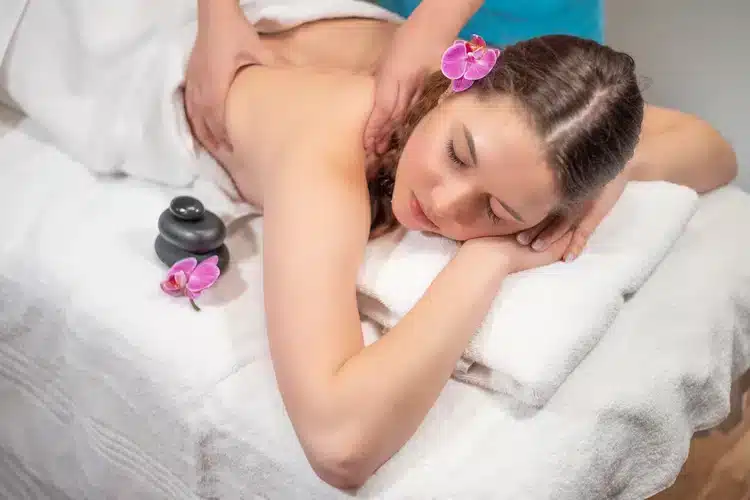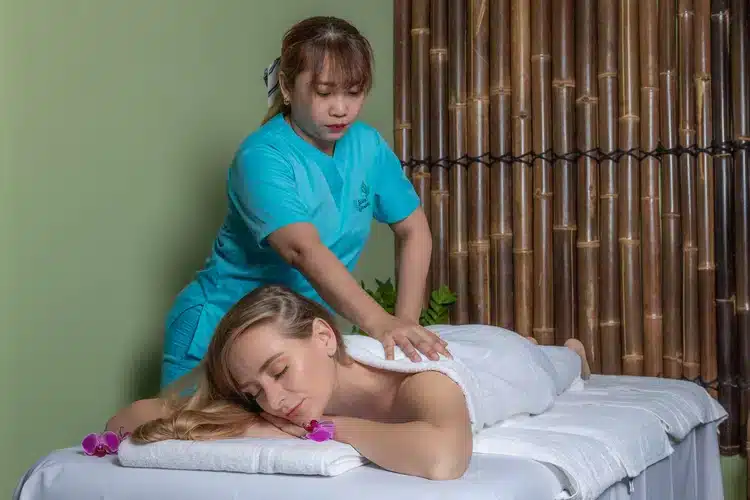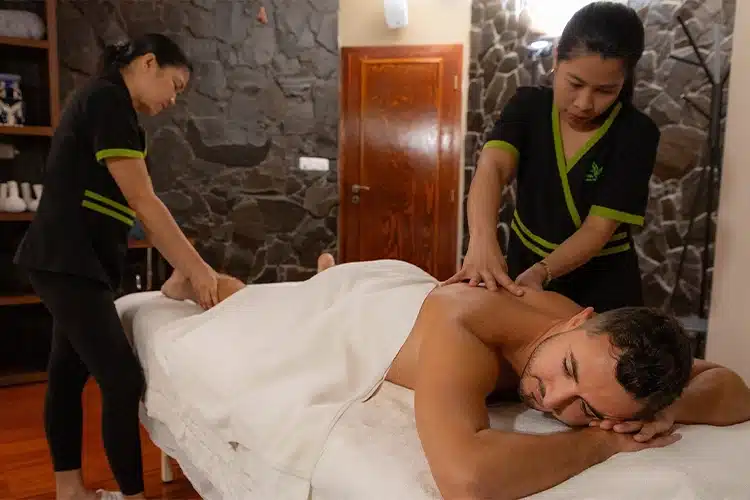Home
Sports massage, often also called deep tissue massage, is one of the most effective tools for sports recovery. It helps relax overworked muscles, improve body awareness, and reduce the risk of injury. Whether you’re preparing for a race, working on a personal best in the gym, or simply counteracting long hours at the computer, recovery is important. The right timing determines whether you maximize the benefits of the massage for your body.
That’s why, in cooperation with our best therapists, we have prepared an easy-to-understand guide based on their many years of experience. Learn how to approach it before activity and after activity, how often to incorporate sports massage, and what to meaningfully combine it with.
What to Expect from a Sports Massage
The goal is not to “endure pain,” but to specifically release overloaded structures – muscle bellies, attachments, fascial lines – and restore their flexibility. The therapist assesses your posture and type of activity (running, strength training, team sports) and accordingly chooses the pressure, pace, and techniques. In practice, it is a combination of smoother strokes for blood flow and more precise, deeper interventions on specific points. The result is a lighter step, greater range of motion, and a subjectively faster return to form.
Massage before Activity
When to schedule it: ideally the day before, or potentially on the morning of the event for shorter, less critical activities.
How it works: a shorter session with medium pressure that activates but doesn’t “overload” the muscles. We work smoothly, focusing on areas crucial for the given discipline – for example, for runners: the hip-lumbar region, hamstrings, and calves; for lifters: hips, core, upper back, and shoulders.
Why it works: the goal is a feeling of readiness and even tension in the muscles. Excessive intensity, on the other hand, could cause unnecessary sensitivity, so we maintain a compromise between relaxation and “kick-starting”..
Massage after Activity
After a run or race: after activity, we recommend a massage no sooner than 6–24 hours later. From experience, we know that an earlier intervention may not be comfortable. Therefore, we choose a longer, calmer pace and adjust the pressure to your current sensitivity.
After strength training: usually after 24 hours or more, depending on how you feel. For very sensitive areas, we start softer and gradually increase the depth.
Session goal: to release residual tension, restore range of motion, and support circulation for better recovery. Also essential is hydration and a gentle pace after the massage; save intense activity for the next day.
How Often to Incorporate Sports Massage
Frequency depends on the level of activity and the goals you want to achieve. For an amateur training 2–3 times a week, a visit once every 1–2 weeks works well. During race preparation or intense training blocks, a visit once a week makes sense, supplemented by one session after a key performance. If you combine sedentary work and recreational sports, the best effect/time ratio is usually an interval of once every 2–3 weeks. This maintains mobility and prevents the gradual “stiffening” typical of office work.
How Recovery Works at Eden’s Garden
The initial visit begins with a brief conversation with the therapist about what your body is currently dealing with – recent workouts, goals, sensitive areas, and so on. Then we smoothly transition to work which combines blood circulation (smooth strokes) and targeted release (deeper, more focused pressure on problematic points). We won’t omit the area that often determines how you feel when running and sitting – hips and core. After each session, you will receive simple recommendations on what to do or not to do in the following days – movement, hydration, sleep, and when to return to full activity.
What Enhances the Effect of Sports Massage
- Light stretching and mobility after activity (without pushing into pain).
- Heat on light days (e.g., sauna) and quality sleep to initiate recovery processes.
- Hydration throughout the day – a glass of water after a massage is essential.
- For specific stiffness, it’s beneficial to add elements of Filipino deep tissue technique – more precise work on attachments and muscle fibers.
Examples in Practice
Runner before a half-marathon
On Tuesday, incorporate short mobility exercises for ankles, hips, and thoracic spine. Just enough to get the body moving without fatigue. On Thursday, schedule a shorter pre-activity sports massage with medium pressure, focused mainly on the calves, hamstrings, and hips. Keep Friday lighter, preferably for light activation and walking. After Saturday’s race, allow your body to rest on Sunday, and between Monday and Tuesday, consider a post-activity massage with lighter pressure, which will support circulation and release overloaded areas.
Strength Training
Mid-week is suitable for targeted deeper work on the back, shoulders, and forearms, which will help with posture and scapular stability. On the weekend, focus on the hips and hamstrings and, depending on your program, optionally add quadriceps or calves. Shorter maintenance sessions of 30–45 minutes can be incorporated anytime you feel stiffness after a more demanding workout. Save deeper techniques for days when you don’t have maximum exertion, and leave at least one day between the massage and intense training.
Sedentary Job + Recreational Sport
If you sit most of the day and your sport is more recreational, a massage once every two to three weeks for 60–90 minutes is sufficient. It is most effective when working on the hips, lower back, neck, and thoracic spine; for mouse users, it’s also beneficial to include forearms and pectoral muscles. Between sessions, a short daily mobility routine of five to ten minutes helps maintain range of motion and reduces the feeling of stiffness.
General
Mild sensitivity after a massage is normal and usually subsides within two days. Before and after the massage, ensure adequate hydration and a calmer pace for the day to allow the body to respond. During the session, always communicate what pressure is comfortable for you – the goal is functional release and improved movement, not pain.
Safety and when to Postpone a Massage
Sports massage, and massages in general, are not suitable for fever, infectious skin diseases, recent injuries, or significant inflammation. If you have a specific diagnosis, consult with a doctor or physiotherapist who can help set up a course of action. Always communicate what you feel during the session – pressure and pace are adjusted to your perception.
Preparation and What to Do after the Session
Before your visit, a light meal is sufficient, and arriving 5–10 minutes early. After the massage, replenish fluids and give your body a gentler pace. The feeling of relaxation will thus gradually linger, and your next workout will “feel” much better.
Are you dealing with a problem or stiffness in a specific area and would you like to follow up with a suitable technique? Next time, you can choose, for example, Filipino massage for precise release of problematic areas, or Thai massage for overall mobility.








